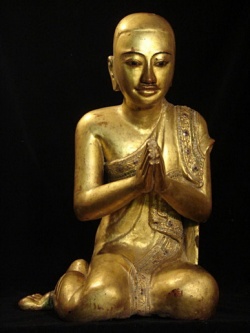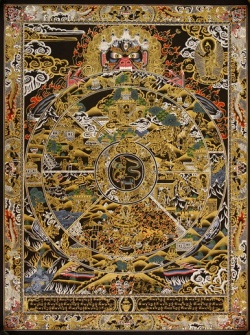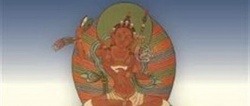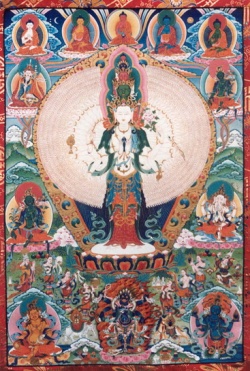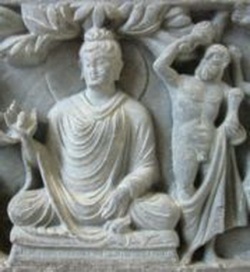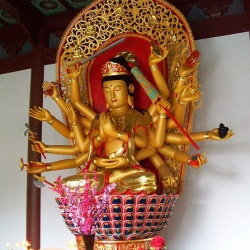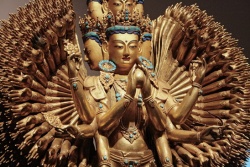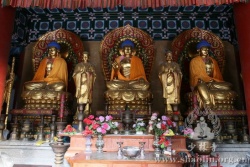A Brief History of the Glorious Drukpa Kagyu Lineage
The Drukpa Kagyu is a wonderful lineage of spiritual practice that stems from Je Gampopa and the latter's disciple Phagmo Drupa.
The Tibetan name "Druk" means "dragon", and the Sri Drukpa Kagyu is therefore known as the Dragon School of the great Kagyu family.
The chief of all Lamas for the Dragon School is Guru Padmasambhava, the "second Buddha," and every tenth day of the lunar month special rituals are celebrated in his honour.
So popular is this School that in Kham, eastern Tibet, there was the saying:
"Half the people are Drukpa, half the Drukpa are wandering Yogins, and half of these Yogins are enlightened saints!"
This is because the teachings of the Drukpa Kagyu especially focused on meditation practice.
Pema Tso Women's Monastery The following briefly gives you the history of the Drukpa lineage.
Phagmo Drupa Dorje Gyalpo (1110-1170)
Phagmo Drupa was born in Kham in far eastern Tibet.
At the age of four he took the vows of a novice monk and began his training on the spiritual path.
He traveled to central Tibet to receive further training from masters residing in the vicinity.
He received his training from a series of masters, including the head of the Sakyapa school, who taught him the complete Lam-Dre teachings.
Thus he attained mastery in Buddhist Philosophy and a technical understanding of the Sutras and Tantras.
Nevertheless, Phagmo Drupa realized that this was not enough; he needed the guidance of a qualified Yogi to transform his meditation into direct realization.
He therefore placed himself at the feet of Gampopa.
Sometime after a brief discussion with the latter, Phagmo Drupa experienced a sudden awakening into the true nature of his own mind, and thereby fully realized ultimate Truth.
During the next few days, following this experience, Phagmo Drupa completely mastered the full and direct realization of Mahamudra.
For the remainder of his life, Phagmo Drupa continued to practice meditation with unceasing perseverance, serving as an example to others.
He later founded a monastery in central Tibet, and had innumerable disciples.
Lingchen Repa Pema Dorje, was born in the village of Langpo Na in the Nyang Tod district of south-central Tibet.
He was the youngest of four children born to Gyalpo Kyongwai, a Tantric practitioner, and his wife Shugmo Darchung.
Lingchen Repa studied under several teachers, one of whom was a doctor in medicine.
On the advice of Lama Khyung Tsangpa, Lingchen Repa became a monk and received his ordination vows from Geshe Womthangpa.
Then, at the age of 37, he decided to travel to Bhutan to contemplate and meditate.
However, before leaving, one night he dreamt that a man in white appeared before him and inspected his body from head to toe.
The man said, "Don't go to Bhutan.
Your soul-purpose will be fulfilled in four and a half years time."
So Lingchen Repa abandoned his plans of traveling to Bhutan.
Four years later, Lingchen Repa heard the name of Phagmo Drupa, and decided to request Phagmo Drupa's teachings.
He therefore traveled to where Phagmo Drupa was then living.
On the sight of the Guru, Lingchen Repa was immediately filled with devotion.
After receiving the teachings of Phagmo Drupa, Lingchen Repa spent the remainder of his life in solitary retreat, and because he too wore the white cotton cloth and led the life of a yogi, he was known as a "Repa".
His spiritual accomplishments gained him a widespread reputation as a great saint.
1st Gyalwang Drukpa Rinpoche (1161-1211)
Dro-gon Tsangpa Gyare Yeshe Dorje, the 1st Gyalwang Drukpa, was born in Nyangto Shulay in southern Tibet, amidst miraculous signs and auspicious omens.
As he was born fully wrapped in a membrane, his superstitious parents were so fearful that they abandoned him.
He was, however, saved and brought up by some yogis and yoginis.
The news of his unusual birth soon spread, and attracted many people to gather around his residence so as to receive his blessings.
When Tsangpa Gyare grew up, he became a disciple of Lingchen Repa, mastering Mahamudra and the Six Yogas of Naropa.
Through refining prana (energy) in the nadis [[subtle channels), and through the practice of Kundalini (Tib: gtum-mo), he became immune to extremes of heat and cold.
Even in the snowy mountains he wore only a white cotton robe, and he too was known, like his Guru, as a "repa", a cotton-clad yogi.
After attaining complete spiritual realization, Tsangpa Gyare went to Lodrak in Central Tibet.
There he revealed a treasure of esoteric instructions called "The Six Equal Tastes," which Rechungpa, the moon-like disciple of Milarepa, had brought back from India and hidden, to be rediscovered at the opportune time by the appropriate person for the benefit of future generations.
Tsangpa Gyare founded the Shedrup Chos-kor Ling Monastery at Ralung in southern Tibet at the command of his root guru, Lingchen Repa, who told him to teach widely.
Thereafter, Tsangpa Gyare went to central Tibet in order to establish a large monastic center in a place especially suitable for spiritual practice.
The monastery that was established there, Druk Sewa Changchub Ling]] ("The Ultimate Dragon Enlightenment Centre"), became the principal monastery of theDrukpa Kargyu for a long time, and the place came to be known as "Nam Druk", which literally means "Sky dragon".
Thus, the lineage became known as the Glorious Dragon Lineage, or Sri Drukpa Kagyu.
Tsangpa Gyare was a famous teacher whose teachings were sometimes attended by as many as 5,000 people at a time.
It was reported that he had 8,800 eminent followers, of whom 280 were enlightened yogis.
His lineage became famous for the yogic asceticism of its adherents and the profundity of its spiritual teachings.
Tsangpa Gyare passed away at the age of 51. Hard though it may be to believe, it is said that when his body was cremated, it was found that his skull bore the images of Arya Manjusri, Avalokiteshvara and Vajrapani, and further images of Arya Tara could be seen on the vertebrates of his spinal column.
Because, in particular, the relics of Tsangpa Gyare manifested different forms of Avalokitesvara, the Bodhisattva of Great Compassion, his devotees believed strongly that he was indeed an emanation of that Bodhisattva.
This explains why Tsangpa Gyare returns again and again, life after life, to watch over the welfare of his students.
Tsangpa Gyare left a prophecy stating that he would be succeeded by nine Dragon throne-holders, each having the term "Senge" (lion) in their name.
After that, there would come three further throne-holders, who would be viewed as living embodiments or emanations of Manjusri (tulku) , Vajrapani, and Avalokiteshvara, respectively.
Then, and only then, after the death of the last of these throne-holders, Tsangpa Gyare would return to guide the Drukpa lineage personally, as the 2nd Gyalwang Drukpa. This is in effect what happened.
Amongst Tsangpa Gyare's students, Gyalwa Go-tsang-pa spread the Drukpa tradition in western Tibet and his followers came to be known as the Upper Drukpa School.
The followers of Choje Lo-repa, another of his students, branched out to form the Lower Drukpa School.
Onray Dharma Senge started the Central Drukpa School and another disciple, Phajo Drugom Zhigpo (1184 - 1251), left for Bhutan following the commnd of Tsangpa Gyare who instructed him to go south of Tibet.
He founded the first Drukpa monasteries in Bhutan at Phachok Deng and Tago.
Thus the Drukpa School spread far and wide. 2nd Gyalwang Drukpa Rinpoche (1428-1476)
The 2nd Gyalwang Drukpa, Kunga Paljor, was not born until two centuries after the time of Tsangpa Gyare.
This does not mean there may not have been intermediate incarnations, only that none were recognized or discovered, and none held the throne of the Drukpa school.
However, exactly as predicted, during these two centuries, there were nine lineage successors, each of whom bore the title or name of "Senge". History also records that these lineage holders of the Drukpa were very learned scholars (pandits), although their greatest achievement was in the exercise of meditation.
Also in line with prophesy, the first nine Dragons were followed by three further spiritual leaders, each of whom was duly recognized in turn as emanations of Manjushri, Vajrapani and Avalokiteshvara.
Kunga Paljor was highly respected for his achievement in the fields of Metaphysics, Philosophy and Sanskrit language. As he was a significant scholar, he often was invited to give teachings.
His outstanding disciples were the Three Crazy-Wisdom Yogis" of Tibet, namely Drukpa Kunley, U-nyon and Tsang-nyon.
The 2nd Drukpa Gyalwang was also the teacher of the renowned yogi Tangtong Gyalpo, later to be reincarnated as Kalu Rinpoche.
The Divine Fool Drukpa Kunley (1455-1520) is still one of the most beloved and revered sages of Tibetan Buddhism.
With his wandering lifestyle, his eccentric and shocking behavior, he taught the essence of the Dharma in ways that may have seemed very humorous, but was actually acutely profound.
His songs and speeches are full of a crude peasant earthiness, which won the hearts of the common people all over Tibet, Bhutan, Ladakh, and Mongolia.
3rd Gyalwang Drukpa Rinpoche (1478-1523)
Jamyang Chodrak, the 3rd Gyalwang, was an erudite and accomplished scholar.
He was a master of both Kagyu and Nyingma transmissions.
Thus the Drukpa School today is very much a union of the teachings and devotional practices of both the Kagyu and Nyingma.
During one three-month meditation period, Jamyang Chodrak also received esoteric pith-instructions in a visionary manner from Rechungpa, Milarepa's moon-like disciple.
The 3rd Gyalwang was famous for displaying miraculous powers.
Frequently he was seen in levitation during meditation, and sometimes, during certain practices, his vajra and bell were also seen rising up and floating in the air.
4th Gyalwang Drukpa Rinpoche (1527-1592), Pema Karpo
Shortly after his birth, Pema Karpo (or Padma Karpo), the 4th Drukpa spiritual head, was heard by many chanting the Six-Syllable Mantra seven times, and therefore, as a child, he was also known as "Ah-Om-Mani-Pa", i.e. the child who chants the Six-Syllable Mantra.
Pema Karpo came to be widely known as "Kunkhyen", meaning "the Omniscient One)".
He has been by far the most famous of all the Drukpa Gyalwangs due to his great wisdom.
During his lifetime, he was known as the greatest Lama amongst all the lamas, and was a teacher to many all over Tibet.
His Holiness the 5th Dalai Lama truly admired Pema Karpo for his knowledge and understanding of the Truth.
Pema Karpo Rinpoche contributed 24 volumes of collected works on Tibetan Buddhist philosophy, logic, literature, history and astronomy, which have been studied by all schools and traditions to this day.
He constructed the great monastery of Druk Sang-ngak Chos-ling ("The Dharma Centre of the Drukpa Secret Mantra") at Jar in southern Tibet, and transferred the seat of the Drukpa school to that centre.
Before passing away, Pema Karpo promised that he would take birth in two separate incarnations, so as to propagate the spiritual lineage.
In accordance with this prophecy, two incarnations were discovered.
5th Gyalwang Drukpa Rinpoche (1593-1653)
The 5th Drukpa throne holder, Pagsam Wangpo, was born in Chongye (in Tsang, western Tibet) into the same family as the 5th Dalai Lama.
He was an extraordinary yogi, and spent many years alone in solitary meditation retreat.
During his time, the Drukpa lineage was most popular in the Himalayan range around northern India, and Pagsam Wangpo received the royal patronage of many kings in the area.
He was a unique yogi as he spent most of his time in solitary retreat.
Pagsam Wangpo had many disciples, the most important of whom was the yogi Tag-tsang-repa, who went to Ladakh at the request of the Buddhist king of that region Senge Namgyal (1570-1642).
In Ladakh, Tag-tsang Rinpoche founded the Hemis Monastery, which remains the principal Drukpa monastery in the area to this day.
Pagsam Wangpo's other disciples were the 1st Dzigar Choktrul Rinpoche, who founded the Dzigar Monastery, and the 1st Khamtrul Rinpoche, who established the Kham-gar Monastery, in La-thog, eastern Tibet.
Both monasteries have been renowned for strict discipline, meditation and the performance of unique Tantric practices.
Kham-gar monastery, under the leadership of the Khamtrul incarnations, became the head of almost two hundred branch monasteries.
Pema Karpo's other reincarnation, Shabdrung Ngawang Namgyal (1594-1651), was born into the royal Gya family.
He was the 18th Abbot of Ralung, the first Drukpa monastery to be established in Tibet.
Following the prophecy of Pema Karpo, Shabdrung Ngawang Namgyal left for western Bhutan, where the Drukpa Kargyu School had already been established, and founded the Cheri Monastery in 1619 in Thimphu valley.
In 1629, he founded his first fortress, Dzong Simtokha, near Thimphu.
As the temporal and spiritual ruler of Bhutan, Shabdrung Ngawang Namgyal unified Bhutan for the first time in its history.
6th Gyalwang Drukpa Rinpoche (1654-1717)
Mipham Wangpo, the 6th Drukpa throne holder, was born in Lhodrak Kharchu.
He was discovered by the 5th Dalai Lama and spent most of his teenage years in the Palace of the Dalai Lama in Lhasa.
He was an erudite master who excelled at debating with the most learned Geshes (doctors of divinity) at the three large monastic universities of Lhasa:
Ganden, Drepung, and Sera
He was important politically during his day, and acted as a mediator during the war between Tibet and Ladakh.
7th Gyalwang Drukpa Rinpoche (1718-1766)
Thinley Shingta, the 7th throne holder, was one of a trio of extraordinary Kagyu Lamas, of whom the other two were the Gyalwa Karmapa and Tai Situ Rinpoche.
He was extremely active in assuring the preservation and promulgation of both the Kagyu and Nyingma traditions.
Thinley Shingta wrote six volumes of philosophical commentaries and meditation instruction.
He established many monasteries.
As official counselor to the king of Nepal, he restored the three principal stupas in the country: Swayambhunath, Boudhanath, and Namo Buddha.
At Swayambhunath, there is a memorial rock describing the meritorious deeds of the 7th Gyalwang Drukpa Rinpoche.
8th Gyalwang Drukpa Rinpoche (1768-1822)
Kunzig Mipham Chokyi Nangwa, the 8th throne holder was an enlightened sage who received numerous revelations from dakinis and higher spiritual beings.
He wrote many volumes about the oral teachings and rituals of the Kagyu.
During his lifetime, he was made the official priest to the Tibetan Government.
He also performed the consecration rites after the Tibetan Government restored Samye monastery.
During these rites many auspicious omens prevailed.
He was famous for his power of prediction, and for recognizing and finding Tulkus, or incarnate lamas.
It was Kunzig Mipham Chokyi Nangwa who officially recognized the 9th Dalai Lama, Lunthok Gyamtso and the Karmapa incarnation of his time.
9th Gyalwang Drukpa Rinpoche (1823-1883)
Mipham Chokyi Gyamtso, the 9th head of the school, was extremely close to both the 14th Karmapa, Theckchok Dorje, and the 8th Pawo Rinpoche.
He spent most of his life meditating in solitude.
10th Gyalwang Drukpa Rinpoche (1884-1930)
Mipham Chokyi Wangpo, the 10th Drukpa throne holder, was the disciple of the supreme yogi-master, Drubwang Shakyasri.
(Shakyasri was likewise the Guru of the renowned yogi master Tipun, whose direct disciple is Lama Chusang Rinpoche.)
Mipham Chokyi Wangpo was not only a great contemplative, but he took an active role politically.
When the British Younghusband Expedition came to Tibet in 1904, and the 13th Dalai Lama sought asylum in China, Mipham Chokyi Wangpo used influence with King Urgyen Wangchuk, the ruler of Bhutan, to seek the withdrawal of British forces from Tibet.
Foreseeing future difficulties for the Drukpa lineage, Mipham Chokyi Wangpo married the daughter of his Guru, the great siddha Shakyasri, and their son, Thuksay Rinpoche, was destined to carry on the Drukpa lineage in exile during the lives of both the 11th and the 12th Drukpa Gyalwangs.
Mipham Chokyi Wangpo was a truly great saint.
When he was cremated, numerous relics were discovered among his ashes, including images of Avalokitesvara that are still among the Drukpa treasures.
11th Gyalwang Drukpa Rinpoche (1931-1960)
Tenzin Khyenrab Gelek Palsangpo, the 11th throne holder, was born in Lhasa and was recognized by many Lamas.
He was the disciple of the exalted yogi Tripun, the root teacher of Bardok Chusang Rinpoche.
Under Tripun's direction, Tenzin Khyenrab Gelek Palsangpo achieved authentic realization and became one of Tibet's great yogis.
He received numerous Dzogchen instructions and empowerments from Dzongsar Khyentse Rinpoche, and spent the greater part of his life in solitary retreat practicing meditation.
During the Cultural Revolution in 1959, the 11th Gyalwang Drukpa inpoche, along with Thuksay Rinpoche, Bardok Chusang Rinpoche, Apho Rinpoche and others, were forced to flee Tibet.
They were only able to take with them a few very sacred items from their monastery, since everything had to be carried on their backs.
They successfully made it to India, but only after suffering many hardships.
Unfortunately, Tenzin Khyenrab Gelek Palsangpo died soon after arriving in the refugee camp at Buxa, West Bengal, near the Bhutanese border in the year 1960.
It is said that prior to his passing, even though he was terribly ill and forced to live in appalling circumstances, he sat for days absorbed in deep meditation without sleeping.
He then promised Thuksay Rinpoche that he would take birth again in this world, so as to continue serving the Dharma and the spiritual evolution of sentient beings. He said that he would take rebirth in India.
Those were in fact his last words, and he passed away in a state of deep Samadhi.
12th Gyalwang Drukpa
12th Gyalwang Drukpa: Jigme Pema Wangchen was born at the sacred lake of Pema Tso Rewalsar), a place connected to Guru Padmasambhava and the Lady Mandarava.
His father is a famous Dzogchen master named Zhichen Bairochana, nowadays commonly known as Bairo Rinpoche.
His mother was Kelsang Yudron, an aristocratic lady from Lhodrak in southern Tibet.
He was enthroned at the 8th Khamtrul Rinpoche's monastery in Dalhousie and later in his own monastery in Darjeeling.
At the age of four, he was taken to Darjeeling, where his main monastery is located.
It was said that he could recognize some of the servants who had served the 11th Drukpa as soon as they came to visit him.
He became the disciple of Thuksey Rinpoche and some of his teachers include His Holiness Dudjom Rinpoche, head of the Nyingma school, Kyabje Trulshik Rinpoche and Pawo Rinpoche.
The 12th Gyalwang Drukpa has re-established a home for the Drukpa lineage in Darjeeling and Kathmandu.
Apart from the monasteries located in the Himalayan region, many Drukpa centres have been opened in Western countries and the Far East.
Gyalwang Drukpa Rinpoche was educated in all the traditional teachings of the Drukpa Kagyu school, starting from the early age of six.
Most of his traditional study and memorization was completed by the age of 13.
Through the encouragement of His Holiness the Dalai Lama he continued his higher education under the great Nyingma master known as Ontrul Rinpoche.
He has a clear ability to convey the teachings of Buddhism in a way that seems directly relevant to the needs of our time.
The simplicity, compassion and humour of his teaching has touched the hearts of all those who have come into contact with him.
The 12th Drukpa throne-holder is now a highly regarded Lama who dedicates himself to bettering the lives of others, while still pursuing the spiritual and contemplative development of a true yogi.
